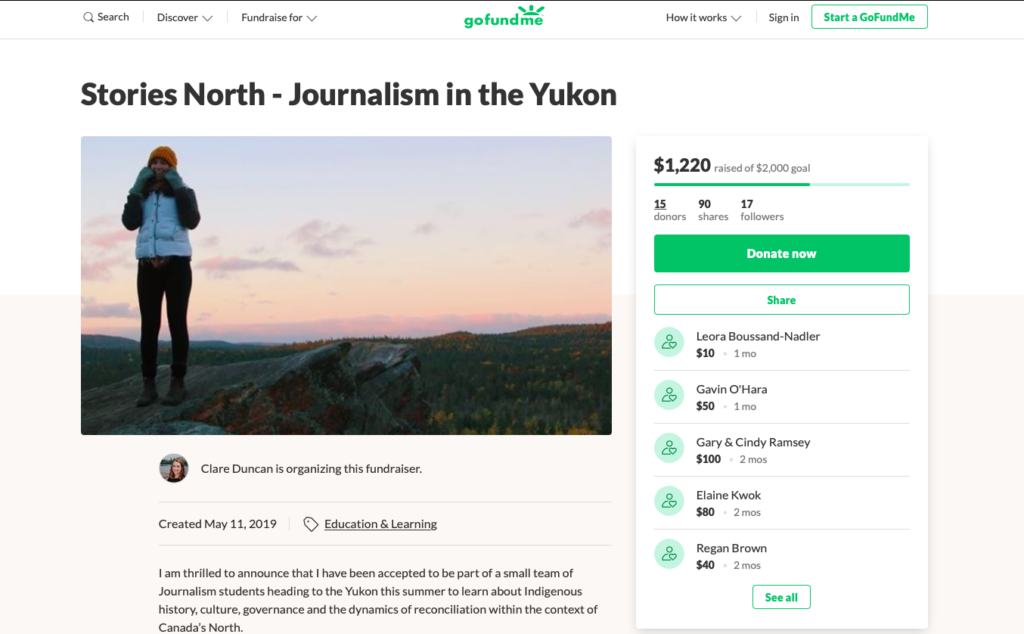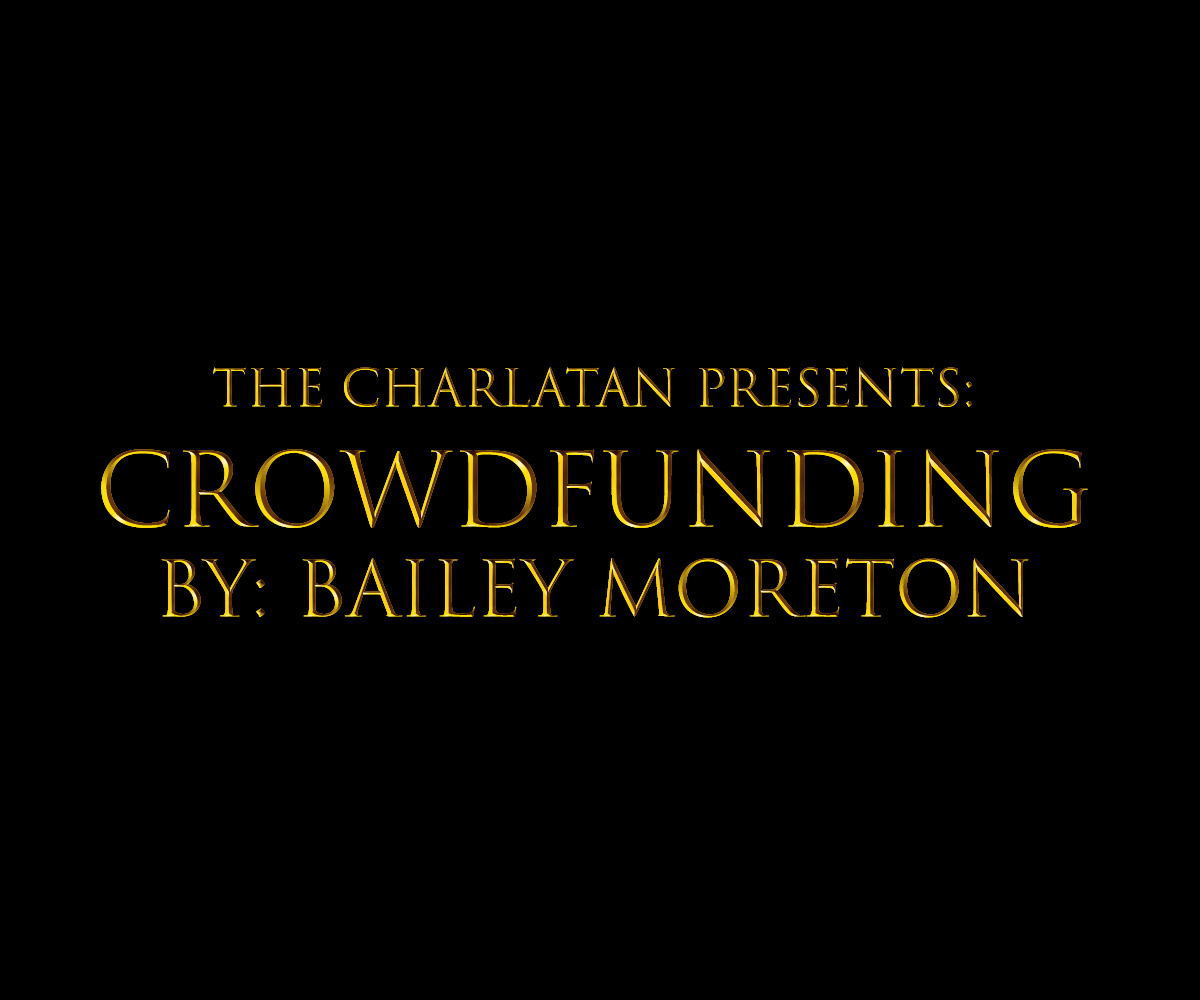Fiona Kenney was in her fourth year of her undergraduate studies at Ryerson University in the creative industries program. She she had her eyes set on the next step her in academic career: a master’s degree from Harvard University.
The good news is that she was accepted. But, the bad news is it was going to cost Kenney nearly ten times as much as what she was paying at Ryerson.
“I had been super focused on getting [accepted] and the application side of it, that I didn’t think about what I would do, were I to get in,” said Fiona Kenney.

Facing a large bill and a tight deadline to come up with the money, one of Kenney’s professors suggested she turn to crowdfunding as a way of raising the money.
Crowdfunding is not a new concept. Young artists turned to the public to fund their work for centuries in Europe. But crowdfunding in its current form emerged with internet-based donating around 10 years ago, when the most famous crowdfunding companies, Kickstarter and GoFundMe, were launched.
Crowdfunding campaigns have normally been reserved for start-ups and charity campaigns. But in 2015, over 34 billion was crowdfunded worldwide.
So many hopeful students are hoping to tap into crowdfunding that GoFundMe now has a page specifically dedicated to those looking to fund their education, with hundreds of campaigns listed.
Depressing numbers
Affording post-secondary education is a big problem for many students. In January, Ontario Premier Doug Ford’s changes to OSAP would see the grace period to start paying back loans after graduating removed and restrictions to who could qualify for grants and loans.
Cuts to the OSAP program pushed Clare Duncan, a fourth-year bachelor of journalism and humanities student at Carleton, to turn to fundraising. She said the removal of the grace period on paying back the loans was a big motivator for her.
“I don’t know what my financial situation is going to be in a year,” she said.
Duncan is using the funds she crowd-raised to participate in the “Stories North” program offered by the journalism department. The program sends journalism students to study at Yukon College and report on the local communities there.
Costs for the program are extensive: several thousand dollars for tuition, flights, food and new camera equipment. In addition to the costs for the program, Duncan has to pay rent for her house in Ottawa while she is away. Some of the costs were covered by sponsorships for the program, and for the crowdfunding, Duncan set a goal of $2,000, lower than what the actual costs will be.
This is a similar approach to the one Na’Shantéa Miller took when she turned to crowdfunding. After getting into Harvard for a master’s degree in public policy, Miller faced a bill of nearly $113,000 a year.

That means Miller had to make up almost $50,000. To do that, she worked and applied for scholarships. She was able to fund her undergraduate degree almost solely through scholarships, Miller said.
“GoFundMe shouldn’t be your only source because it again, it’s a risk,” she said. “You don’t know, there’s no guarantees.”
On the same day OSAP cuts were announced, Ford also declared there would be a 10 per cent cut in post-secondary tuition, the first time this has happened since 1990. But, according to the chart below, this would only take tuition back to 2015-2016 levels.
In 1990-1991, average undergraduate tuition fees in Canada were $1,464. In the 2018-2019 academic year, average tuition rates were $6,838, an increase of over 400 per cent, according to Statistics Canada.
Adding to struggles for students like Miller or Duncan, rent prices have skyrocketed, more than doubling in Toronto since 1990.
Meanwhile, the average hourly wage for full-time workers in Canada increased less than 50 cents for men and around three dollars for women from 1990 to 2011.
The response
When she told her parents about turning to crowdfunding, Kenney said they were supportive, but cynical.
“They said, ‘Don’t expect too much from it.’”
But through support from professors, students in her program, work colleagues of her parents and strangers who found the GoFundMe through social media, she raised over $10,000 to go towards tuition and rent.
Everyone was generally supportive, apart from one person who commented on social media that she should have been working instead, said Kenney.
She understood where the person was coming from, Kenney said, and made a particular effort to show on her online profile that she had been working full time during her studies. Everybody else was positive and supportive, she said.
Miller’s close circle of family and friends were supportive of her turning to crowdfunding, but when she first posted her campaign on social media, she got a mixed reaction.
“When I put it on Facebook, [later] the same day a former colleague sent me a link to a Reddit page that was created about me making fun of me, you know?”
“I don’t regret my decision of trying, because even if I didn’t raise $50,000, at least I could tell myself that I tried and it didn’t work out. And there’s no, “What if?” I just know, it didn’t work out.” – Na’Shantéa Miller.
Initially, Duncan was hesitant about crowdfunding.
“I was just scared to ask people for money because it sort of made myself vulnerable,” she said.
“It was hard for me to let my friends and my family know what I was doing because I didn’t want them to think less of me for asking for money.”
When she did first start a campaign, she only opened her crowdfunding page to family members and friends, only publishing it publicly on social media later.
“My preconceived notion was that I wouldn’t get any feedback,” Duncan said.

“But some people did surprise me, like one girl I went to summer camp with. She’s a year older than me, we were never close friends and I hadn’t spoken to her years,” she said.
“But she reached out to me and said, ‘Hey, Clare, I want to donate to this, I think this is a really great cause.’”
Keys to crowdfunding
Working on the description of the fundraiser and her own biography on GoFundMe site was key, Kenney said.
“I was very intentional with how I was writing that and saying, ‘okay, this is what I’ve been doing until now.’ I’m clearly working hard. I’m not just looking for handouts that I haven’t worked for,” she said.
“Making sure that my narrative was crafted truthfully and intentionally, and definitely mentioning the school name, helped as well.”
Kenney doesn’t plan on returning to crowdfunding because she feels she tapped out the resource, but is optimistic about its potential for other people.
It is a lot to ask of people, but showing that you have a clear plan for the money is also key, added Kenney.
“What’s important is demonstrating that it’s a starting point,” she said. “I don’t think people would be as willing to support if they were like, ‘Okay, this is just indefinite, what’s going to happen after this? What’s your plan?’”
“I think it’s definitely feasible for students who have a clear plan and understand that it’s a short-term solution,” she said.
–With files from Tim Austen
-Feature image by Tim Austen






